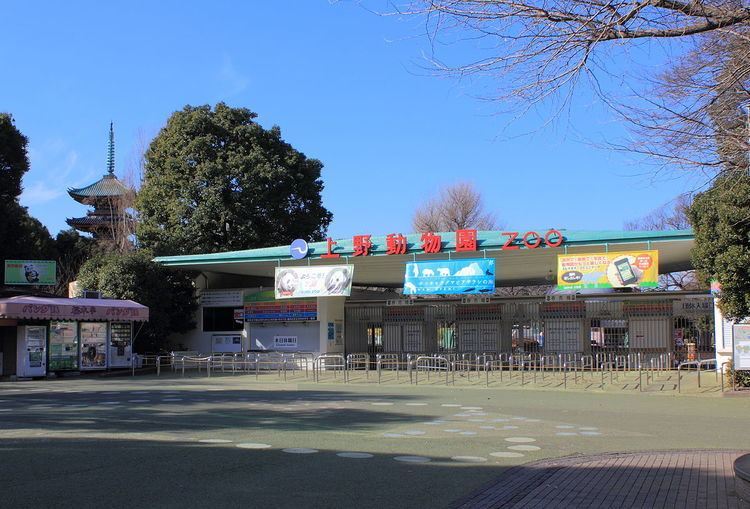Date opened 1882 Land area 14.3 ha (35 acres) No. of species 464 Opened 1882 | No. of animals 2600 Memberships JAZA Area 14 ha | |
 | ||
Hours Open today · 9:30AM–5PMFriday9:30AM–5PMSaturday9:30AM–5PMSunday9:30AM–5PMMondayClosedTuesday9:30AM–5PMWednesday9:30AM–5PMThursday9:30AM–5PMSuggest an edit Similar Tama Zoological Park, National Museum of Nature an, Tokyo Sea Life Park, 東武動物公園 Tobu Zoo, Ueno Park Profiles | ||
G k in japan day 12 ueno zoo
The Ueno Zoo (恩賜上野動物園, Onshi Ueno Dōbutsuen) is a 14.3-hectare (35-acre) zoo, managed by the Tokyo Metropolitan Government, and located in Taitō, Tokyo, Japan. It is Japan's oldest zoo, opening on March 20, 1882. It is a five-minute walk from the Park Exit of Ueno Station, with convenient access from Tokyo's public-transportation network. The Ueno Zoo Monorail, the first monorail in the country, connects the eastern and western parts of the grounds.
Contents
- G k in japan day 12 ueno zoo
- Ueno zoo subtokyo 175
- History
- World War II
- Recent renovations
- Animal population
- Principal animals
- References
The zoo is in Ueno Park, a large urban park that is home to museums, a small amusement park, and other attractions. The zoo is closed Mondays (Tuesday if Monday is a holiday).
Ueno zoo subtokyo 175
History
The zoo started life as a menagerie attached to the National Museum of Natural History. In 1881, responsibility for this menagerie was handed to naturalist and civil servant Tanaka Yoshio, who oversaw its transition into a public zoo. The ground was originally estate of the imperial family, but was bestowed (恩賜, onshi, forming the first part of the name in Japanese, untranslated officially) to the municipal government in 1924 — along with Ueno Park — on the occasion of crown prince Hirohito's wedding.
World War II
In August 1943, the administrator of Tokyo, Shigeo Ōdachi, ordered that all "wild and dangerous animals" at the zoo be killed, claiming that bombs could hit the zoo and escaping wild animals would wreak havoc in the streets of Tokyo. Requests by the staff at the zoo for a reprieve, or to evacuate the animals elsewhere, were refused. The animals were executed primarily by poisoning, strangulation or by simply placing the animals on starvation diets. A memorial service was held for the animals in September 1943 (while two of the elephants were still starving) and a permanent memorial (built anew in 1975) can be found in the Ueno Zoo.
Shortly after the March 1945 bombings of Tokyo, the Japanese placed U.S. Army Air Force navigator and bombardier Ray "Hap" Halloran on display naked in a Ueno Zoo tiger cage so civilians could walk in front of the cage and view the B-29 prisoner.
Recent renovations
The zoo provides animals an environment similar to the natural habitat. In recent years, the old-fashioned cages of the past have been replaced with modern habitats, such as the "Gorilla Woods," built after two well-publicized mishaps in 1999.
Animal population
The zoo is home to more than 3.000 individuals representing over 400 species. The Sumatran tiger, and western lowland gorilla head the list of the zoo's population. Ueno has more species on exhibition than any other zoo in Japan.
The zoo is also home to zebras, Japanese macaques, red-crowned cranes, white-tailed eagles and king penguins, along with goats, sheep, pigs, llamas, ostriches, and rabbits.
At some point, redistribution of the animals among Tokyo's other zoos (including Tama Zoo and Inokashira Nature Park) left Ueno without a lion. However, in response to public demand, Ueno borrowed a female from the Yokohama Municipal Zoo.
Principal animals
After the death of Giant panda Ling Ling in 2008, Ueno Zoo was without a member of this species for the first time since 1972. Two new giant pandas arrived from the Chinese Wolong Nature Reserve in February 2011. The male panda, Billy (比力 ビーリー) was renamed in Ueno to Līlī (力力 リーリー) to emphasize his playful vitality. The female's name Siennyu (仙女 シィエンニュ ‘Fairy’) was changed to Shinshin (真真 シンシン), referring to purity (純真) and innocence (天真). The new names were based on a public poll. The final choices picked by the zoo were, however, not among top choices. Reduplication is very common in panda names.
Other animals housed at the zoo include red pandas, Sumatran tigers, Asiatic lions, Western lowland gorillas, Polar bears, Asian elephants, Reticulated giraffes, American bison, otters, red foxes, bats, toucans, tapirs, kangaroos, California sea lions, fennec foxes, pygmy hippos, hippos, okapis, anteaters, crocodiles, turtles, flamingos, lemurs, pelicans, puffins and white rhinoceroses.
